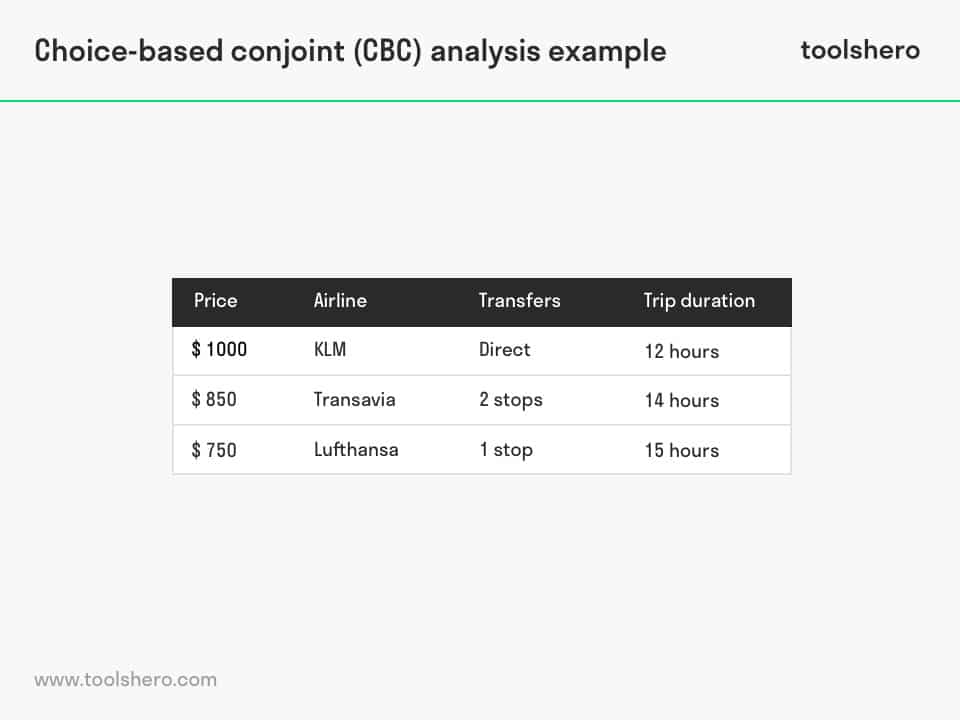Conjoint Analysis (CA)

Conjoint Analysis: this article offers a practical explanation of Conjoint Analysis (CA). You will read about the definition of this concept, the different terms associated with this analysis and the two types of conjoint analysis. Enjoy reading!
What is Conjoint Analysis?
Definition
A Conjoint Analysis (CA) is a statistical method for market research. This mainly concerns measuring the relative importance of certain characteristics of a product or service. The product or service is subdivided into inseparable characteristics or functions that are subsequently presented to the consumer in the form of a questionnaire or telephone conversation, for instance.
The respondents are asked to select the most favourable or most desirable group of functions or features, depending on the type of Conjoint Analysis. This allows companies to better meet the actual wishes and needs of the consumers.
A manufacturer of electronic devices, for instance, would like to know whether his customers prioritise the sound and image quality over price or vice versa. In principle, it resembles a multi-criteria analysis (MCA), but it goes beyond such an analysis because it calculates the mathematical values to explain consumer behaviour.
Market research based on conjoint analysis is concerned with why and how people choose between products or services and their properties. Subsequently, the product development team can use the new input, allowing the company to fulfil the customer’s wishes in a profitable way.
Data and feedback can be obtained by conducting experiments on customers or by conducting questionnaires with the goal to model the purchase process and purchase decision. Subsequently, this data can be linked to, for instance, demographic data of the customer type, lifestyle or other customer profiles.
The conjoint analysis arose in mathematical psychology and was developed by marketing professor Paul E. Green at the university of Pennsylvania in 1970.
Conjoint Analysis Terminology
In the process of a conjoint analysis, various specific terms arise that must be correctly interpreted. These terms will be discussed in the following sections:
Attributes / characteristics
This refers to a characteristic of a service or product. In the example from the following section, 4 attributes have been included: price, airline, transfers and travel duration.
Levels
Levels refer to the various steps or measurements for the previously mentioned attribute or characteristic. The price from the example is subdivided into 3 levels, each with a different amount.
Card
A card is a combination of multiple attributes.
Set
A set refers to a group of cards. Respondents are often asked to choose from the set of cards.
Part-worth utilities
A collection of the most valuable results from the Conjoint Analysis.
Types of Conjoint Analyses
There are many different types of conjoint analyses, but their use is completely dependent upon what the user wishes to accomplish. From conjoint analyses conducted based on algorithms to simple questionnaires or combined types; a conjoint analysis can be designed completely according to the user’s wishes.
The most important two types of conjoint analyses are described below:
Choice-based Conjoint Analysis (CBC)
Choice-based conjoint (CBC) is preferred over other types of conjoint analyses in many cases. This type of conjoint analysis is used in determining the price of a service or product in relation to the attributes or functions.
CBC is effective when the acquired data is concrete, such as various product attributes that influence each other or when it concerns price. A CBC conjoint analysis is usually limited to approximately 8 attributes.
An example. An airline researches the consumers’ willingness to buy tickets and what they feel is important here. Attributes and levels must be added in order to use a choice-based conjoint analysis. In this case, 4 attributes and 3 levels are added:

Figure 1 – Example conjoint analysis
All options take the passenger to the same destination, but ticket number 1 does so within 12 hours, while option number 3 takes 15 hours for 250 euros less. Surveyors ask their respondents to choose a ticket and gather information about what exactly led to this decision. By gathering and analysing as many responses as possible, one can determine how important the interaction between travel time and costs is.
Adaptive Conjoint Analysis (ACA)
When the number of attributes is higher than 8, an adaptive conjoint analysis (ACA) can be more useful. An ACA utilises the same overarching principles as a CBC analysis, but differs significantly in terms of subject, implementation and analysis.
Where the CBC gives respondents the choice between multiple products that are described by means of a set of attributes, the ACA gives a description with all attributes as pairs, the aforementioned cards. The advantage is that a large number of characteristics can be used, up to as much as 30 attributes, each with 7 levels. A computer manufacturer can use this analysis to research which set of specifications is most desired by the consumer.
The disadvantage of an ACA analysis is that the large number of attributes means the survey will take at least 45 minutes or longer. Another disadvantage of the ACA version of the conjoint analysis is that the survey is difficult to do by phone, and questionnaires on paper are impossible. In this case, software with algorithms are often used.
Analysing Survey Data
Depending on the number of attributes, the respondents usually fill out 10-30 questions or preferences. These questions are carefully designed. For example, the attributes must be independent from each other. Thanks to this independence, the analyst can statistically determine which product characteristics are most desired and which most influence the decision.
The result is a series of preferential scores, referred to as part-worth utilities or partial values. The researcher subsequently use a conjoint market simulator to define specific contexts where he makes a specific product compete with another product. This simulator allows for the creation of different what-if scenarios.
Software plays an important role in analysing the survey data. The software must find out which product is best, or how good each individual product is. Annually, thousands of conjoint analyses are conducted, by phone, the Internet or in person during interviews. Organisations use the data and the analysis results to justify price decisions, design new products or save on development costs.
Now It’s Your Turn
What do you think? Do you recognise the explanation of the conjoint analysis? How do you believe a conjoint analysis can be applied in your company or market research? Which variations or combinations do you use? Do you have any tips or additional comments?
Share your experience and knowledge in the comments box below.
More information
- Green, P. E., & Srinivasan, V. (1990). Conjoint analysis in marketing: new developments with implications for research and practice. The journal of marketing, 3-19.
- Churchill, G. A., & Iacobucci, D. (2006). Marketing research: methodological foundations. New York: Dryden Press.
- Wittink, D. R., & Cattin, P. (1989). Commercial use of conjoint analysis: An update. The Journal of Marketing, 91-96.
How to cite this article:
Janse, B. (2018). Conjoint Analysis (CA). Retrieved [insert date] from Toolshero: https://www.toolshero.com/marketing/conjoint-analysis/
Original publication date: 01/18/2019 | Last update: 08/20/2023
Add a link to this page on your website:
<a href=”https://www.toolshero.com/marketing/conjoint-analysis/”>Toolshero: Conjoint Analysis (CA)</a>









